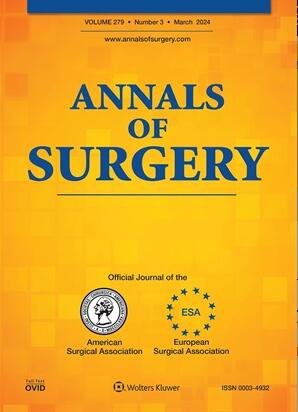冷冻象鼻技术减少混合主动脉弓急性主动脉夹层患者循环骤停时间:153例多中心队列患者的早期和中期结果
IF 6.4
1区 医学
Q1 SURGERY
引用次数: 0
摘要
目的比较传统冷冻象鼻(FET)技术与新方法治疗急性主动脉夹层(AAD)的效果。背景:冷冻象鼻彻底改变了广泛主动脉病变的治疗。低温循环停止是一种建议,但仍然是最大的负担。我们的FET(简化分娩-FET)手术方法允许在正常体温下进行远端缝合,缩短循环停止时间。方法:这是一项非随机、多中心、回顾性研究,研究对象是所有采用正常灌注(SD-FET)或常规FET(对照)技术接受全弓置换术治疗AAD的患者。主要终点是住院死亡率、中风和脊髓损伤。结果共纳入153例患者,其中SD-FET 90例,对照组FET 63例。总体而言,SD-FET组住院死亡率为13.3% (n=20), 10.3% (n=9),对照组住院死亡率为27.5% (n=11) (P=0.206)。两组术后卒中和脊髓损伤发生率无差异。SD-FET对综合结果(死亡和/或神经事件)具有保护作用,相应的人群平均事件百分比SD-FET组为17.8%(5.3- 27.7%),而FET组为30.7%(16.5-52.8)。Kaplan-Meier结果显示,SD-FET组12个月和24个月生存率分别为87%和83%,SD-FET组为86%和80% (P=0.625)。结论SD-FET技术可以在不冷却的情况下进行混合弓手术,并且与较低的死亡和/或神经事件联合标准发生率相关。本文章由计算机程序翻译,如有差异,请以英文原文为准。
A Frozen Elephant Trunk Technique to Reduce Circulatory Arrest Time in Hybrid Aortic Arch for Acute Aortic Dissection: Early and Midterm Outcomes in a Multicentric Cohort of 153 Patients.
OBJECTIVE
This study compared the results of the conventional Frozen Elephant Trunk (FET) technique with those of a new approach for the treatment of Acute Aortic Dissection (AAD).
SUMMARY BACKGROUND DATA
Frozen Elephant Trunk has revolutionized the treatment of extensive aortic pathologies. Hypothermic circulatory arrest is a recommendation for its implementation but remains the greatest burden. Our approach for the FET (Simplified Delivery-FET) procedure allows distal suturing in normothermia with a shorter circulatory arrest time.
METHODS
This was a non-randomized, multicenter, retrospective study of all patients who underwent total arch replacement for AAD using either the normothermia (SD-FET) or conventional FET (control) techniques. The primary endpoints were in-hospital mortality, stroke, and spinal cord injury.
RESULTS
One hundred and fifty-three patients were included (n=90 SD-FET; n=63 control FET). Overall, in-hospital mortality was 13.3% (n=20), 10.3% (n=9) in the SD-FET group and 27.5% (n=11) in the control FET group (P=0.206). There were no differences in the rates of postoperative stroke and spinal cord injury. SD-FET was protective for combined outcome (death and/or neurological event) with a corresponding population-average percentage of events of 17.8% (5.3-27.7) in the SD-FET group versus 30.7% (16.5-52.8) in the FET group. The Kaplan-Meier showed a survival rate at 12 and 24 months of 87% in the SD-FET group versus 83% in the FET group and 86% in the SD-FET group versus 80% FET (P=0.625), respectively.
CONCLUSIONS
The SD-FET technique allows hybrid arch surgery to be performed without cooling and is associated with a lower incidence of the combined criteria of death and/or neurological events.
求助全文
通过发布文献求助,成功后即可免费获取论文全文。
去求助
来源期刊

Annals of surgery
医学-外科
CiteScore
14.40
自引率
4.40%
发文量
687
审稿时长
4 months
期刊介绍:
The Annals of Surgery is a renowned surgery journal, recognized globally for its extensive scholarly references. It serves as a valuable resource for the international medical community by disseminating knowledge regarding important developments in surgical science and practice. Surgeons regularly turn to the Annals of Surgery to stay updated on innovative practices and techniques. The journal also offers special editorial features such as "Advances in Surgical Technique," offering timely coverage of ongoing clinical issues. Additionally, the journal publishes monthly review articles that address the latest concerns in surgical practice.
 求助内容:
求助内容: 应助结果提醒方式:
应助结果提醒方式:


